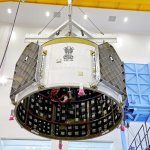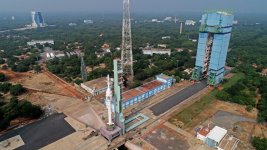This is one of the coolest things to have happened in this country's history!! Godspeed ISRO!
Gaganyaan Mission : ISRO to send Indian into space by 2022
- Thread starter Ashwin
- Start date
You are using an out of date browser. It may not display this or other websites correctly.
You should upgrade or use an alternative browser.
You should upgrade or use an alternative browser.
They know better but I think the selection of White color for exterior is a strange one. Re-entry temperatures usually char the exteriors. It will look like a burnt piece of toast when it gets back. Maybe a metallic or black color could camaflogue it.
This module is for the 1st flight ejection/escape test. The module won't leave the atmosphere & thus won't have to re-enter. They will do the ejection at 17 km height & at Mach 1.2 speed. This is why you don't see the ablation protection tiles on the belly pan.They know better but I think the selection of White color for exterior is a strange one. Re-entry temperatures usually char the exteriors. It will look like a burnt piece of toast when it gets back. Maybe a metallic or black color could camaflogue it.
The next flight ejection will probably happen at a much higher altitude.
So helicopter test will be done before integration with rocket. Since launch is supposed to be done by the end of the month, I guess helo test will be done in the next few days.

 www.wionews.com
www.wionews.com

ISRO to take possession of Gaganyaan Crew Module for helicopter-drop tests
As part of the ongoing testing process for the Gaganyaan Human spaceflight mission, the Indian space agency is to take possession of crucial flight hardware. Known as the Integrated Air Drop Test (IADT-CM) Crew Module structure, this is the shell within which the Indian astronauts would be...
This module is for the 1st flight ejection/escape test. The module won't leave the atmosphere & thus won't have to re-enter. They will do the ejection at 17 km height & at Mach 1.2 speed. This is why you don't see the ablation protection tiles on the belly pan.
The next flight ejection will probably happen at a much higher altitude.
Makes sense, but I also think that a circular window might have been safer for structural integrity. But of course, they must have taken all that into consideration for the design and tested. Pretty large window for a crew module. And only one. A few, smaller round windows could have been an option.
That is the port for entry/exit of the vyomanauts. read somewhere that this port will be sealed using pyrobolts.Makes sense, but I also think that a circular window might have been safer for structural integrity. But of course, they must have taken all that into consideration for the design and tested. Pretty large window for a crew module. And only one. A few, smaller round windows could have been an option.
That is the port for entry/exit of the vyomanauts. read somewhere that this port will be sealed using pyrobolts.
Yes, fireblot for easy egress is standard for crew modules. I think this was first done after the Apollo1 fire.
. The first development flight Test Vehicle (TV-D1) is in the final stages of preparation. The Test Vehicle is a single-stage liquid rocket developed for this abort mission. The payloads consist of the Crew Module and Crew Escape Systems (CES) with their fast-acting solid motors, along with CM fairing (CMF) and Interface Adapters.
This flight will simulate the abort condition during the ascent trajectory corresponding to a Mach number of 1.2 encountered in the Gaganyaan mission. CES with CM will be separated from the Test Vehicle at an altitude of about 17 km. Subsequently, the abort sequence will be executed autonomously commencing with the separation of CES and deployment of the series of parachutes, finally culminating in the safe touchdown of CM in the sea, about 10 km from the coast of Sriharikota, the ISRO said.

 www.newindianexpress.com
www.newindianexpress.com
This flight will simulate the abort condition during the ascent trajectory corresponding to a Mach number of 1.2 encountered in the Gaganyaan mission. CES with CM will be separated from the Test Vehicle at an altitude of about 17 km. Subsequently, the abort sequence will be executed autonomously commencing with the separation of CES and deployment of the series of parachutes, finally culminating in the safe touchdown of CM in the sea, about 10 km from the coast of Sriharikota, the ISRO said.

Gaganyaan mission: Crew safety test to be undertaken shortly, says ISRO
Acting Director of ISRO's Human Space Flight Centre (HSFC), R Hutton pointed out that the integrated air-drop test is one of the important exercises in evaluating the various systems of Gaganyaan.
Prime Minister reviews readiness of Gaganyaan Mission
Indian Space Station to be set up by 2035
India to send Man to Moon by 2040
India to undertake missions to Venus and Mars
Indian Space Station to be set up by 2035
India to send Man to Moon by 2040
India to undertake missions to Venus and Mars
Posted On: 17 OCT 2023 1:53 PM by PIB Delhi
Prime Minister Shri Narendra Modi chaired a high-level meeting to assess progress of India’s Gaganyaan Mission and to outline the future of India’s space exploration endeavours.
The Department of Space presented a comprehensive overview of the Gaganyaan Mission, including various technologies developed so far such as human-rated launch vehicles and system qualification. It was noted that around 20 major tests, including 3 uncrewed missions of the Human Rated Launch Vehicle (HLVM3) are planned. First demonstration flight of the Crew Escape System Test Vehicle is scheduled on 21 October. The meeting evaluated the mission’s readiness, affirming its launch in 2025.
Building on the success of the Indian space initiatives, including the recent Chandrayan-3 and Aditya L1 Missions, Prime Minister directed that India should now aim for new and ambitious goals, including setting up ‘Bharatiya Antariksha Station’ (Indian Space Station) by 2035 and sending first Indian to the Moon by 2040.
To realize this Vision, the Department of Space will develop a roadmap for Moon exploration. This will encompass a series of Chandrayaan missions, the development of a Next Generation Launch Vehicle (NGLV), construction of a new launch pad, setting up human-centric Laboratories and associated technologies.
Prime Minister also called upon Indian scientists to work towards interplanetary missions that would include a Venus Orbiter Mission and a Mars Lander.
Prime Minister Modi expressed confidence in India’s capabilities and affirmed the nation's commitment to scaling new heights in space exploration.
Prime Minister reviews readiness of Gaganyaan Mission
@Ashwin @randomradio @Parthu.









































